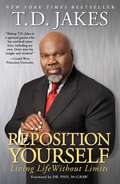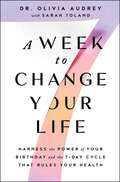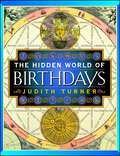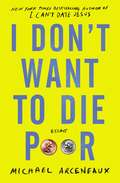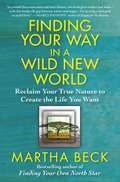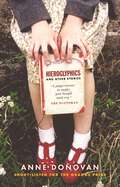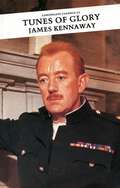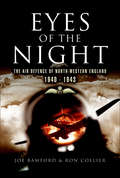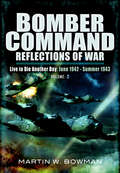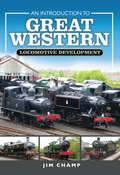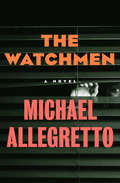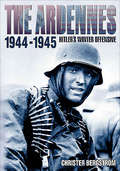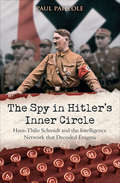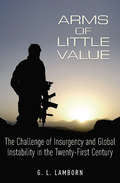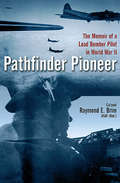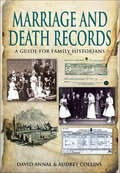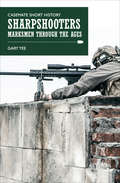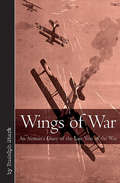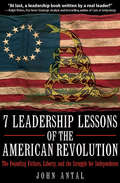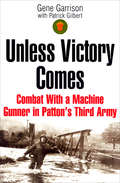- Table View
- List View
Reposition Yourself: Living Life Without Limits
by T.D. JakesLife should be full of success, spirituality, and happy relationships, but we often settle for less—Reposition Yourself is a guide for living a more prosperous life through Christian principles.The star of BET&’s Mind, Body & Soul, and featured guest speaker on Oprah&’s Lifeclass, Potters House pastor T.D. Jakes offers readers the New York Times bestselling Reposition Yourself: Living Life Without Limits, an inspirational narrative self-help book that provides the spiritual underpinnings of his message about applying Christian principles to adjust to the many changes that life brings. In the vein of Joel Osteen&’s Become a Better You and Dr. Phil&’s Life Strategies, Reposition Yourself uses wisdom collected from more than thirty years of Jakes&’s experience counseling and working with high-profile and everyday people on financial, relational, and spiritual creativity on the path to an enriched life filled with contentment at every stage.
The Magic of Food: Live Longer and Healthier--and Lose Weight--with the Synergetic Diet
by Michael T. MurrayFrom &“a pioneer in alternative health&” (Dr. Oz), doctor of natural medicine, and the co-author of the Encyclopedia of Healing Foods and The Encyclopedia of Natural Medicine comes this accessible and comprehensive eating plan based on his extensive knowledge of food as medicine to promote optimum health.Food affects our body, mind, and health in many remarkable ways. And certain foods work together in ways that are almost magical. In this groundbreaking new eating plan, Michael Murray, ND, identifies foods that act together to produce a total effect or force that is greater than the sum of the individual foods—what is known as a synergetic effect. Research shows there&’s a tremendous synergetic effect that the healing force of nature exerts through each food and each food component. As the foods work together, they improve your energy and your physical and mental health. Michael Murray&’s years of research and clinical experience have led to a definitive understanding of how specific foods affect us. He presents his findings on phytochemicals and other nutrients and why they&’re the new &“vitamins,&” discusses specific healing foods and how to combine them, and explains the principles to follow for eating the most synergetic foods every day. Here also are practical and prescriptive recipes and helpful guidelines for better and delicious eating. All this is in a usable and entertaining guide that you will turn to again and again as you develop your own personalized program for using food as medicine.
A Week to Change Your Life: Harness the Power of Your Birthday and the 7-Day Cycle That Rules Your Health
by Dr Olivia AudreyRenowned naturopathic doctor to the stars shares a &“perfect roadmap&” (Dr. Mike Moreno, New York Times bestselling author of The 17 Day Diet book series) to the life-changing seven-day plan personalized to you and your birthday that can radically improve your health and well-being.Do you regularly get the Monday Blues? Are you always tired on Fridays, even though you want to be excited for the weekend? There may be more to it than just a long work week. Over the course of a week, the human body goes through a cycle of self-regulation. Our energy levels, inflammation levels, capacity to focus, and even our immunity all fluctuate naturally based on this internal seven-day cycle, scientifically known as the circaseptan rhythm. Now, Dr. Olivia Audrey reveals how we can tap into the power of this seven-day cycle to transform our health and overhaul our mind and mood. The key to understanding your own circaseptan rhythm is, remarkably, from the day of the week on which you were born. The birth experience is like a hormonal storm that inflames the body, one that is repeated week after week with an ebb and flow of inflammation and repair that lasts seven days. This cycle has a measurable impact on mood, energy, and all the facets of physical health. Dr. Audrey&’s protocol provides instructions for aligning your health goals with your body&’s natural circaseptan rhythm, unlocking extraordinary benefits. With her accessible writing and actionable advice, Dr. Audrey reveals the secret to harnessing your body&’s natural rhythm in order to heal whatever ails you and boost how you look, feel, and live. This plan can be effective for losing weight, gaining focus, fighting specific diseases, or simply feeling more in tune with your life. A Week to Change Your Life is the ultimate program to &“show us a different way of looking at the problems, reminding us to keep practicing and to feel joy,&” (Sarah Ferguson, Duchess of York) so you can create a life of radiant health and energy.
The Hidden World of Birthdays
by Judith TurnerUnlock the secrets of your personality with this captivating guide by world-renowned psychic Judith Turner that combines astrology, psychology, and psychic insights to reveal the hidden truths linked to your birth date.Have you ever considered what your birthday truly signifies? It is not just a date on the calendar—it&’s a treasure trove of insights into your identity, personality, and potential. Packed with personalized insights, this enlightening guide offers a fresh perspective on who you are and who you can become. Did you know that you have a specific flower, gem, and fragrance specifically tied to you? Are you aware of your lucky numbers, the name of your guardian angel, or even the ideal day of the week to request a raise? Each person carries unique traits, and every birthday is a reflection of the individual born on that day. With The Hidden World of Birthdays, you&’ll be able to: · Discover the gems and stones that align with your energy, bringing luck, strength, and encouragement. · Learn which colors enhance your charisma and charm, soothing your spirit during life&’s challenges. · Explore the realm of luck with personalized numbers, months, and days of the week that resonate with your life&’s journey. · Uncover the most compatible astrological signs for your relationships and partnerships. · Meet your spiritual guides—your star, angel, guardian angel, and spiritual stone—that enrich your life and guide you on your path. But that&’s not all. Each birthday features an exclusive section called &“Judith&’s Insight,&” offering personalized guidance to help you make informed life choices. These insights not only reveal who you are but also the incredible potential within, illuminating the paths you can take toward personal growth and fulfillment. With The Hidden World of Birthdays, you'll embark on a journey of self-discovery, gaining invaluable insights that can transform your understanding of yourself and your place in the universe. Ready to uncover the hidden truths of your birthday? Keep this book close—it&’s timeless, revealing new insights each time you open it!
I Don't Want to Die Poor: Essays
by Michael ArceneauxOne of NPR&’s Best Books of 2020 One of Time&’s 100 Must-Read Books of 2020 From the New York Times bestselling author of I Can&’t Date Jesus, which Vogue called &“a piece of personal and cultural storytelling that is as fun as it is illuminating,&” comes a wry and insightful essay collection that explores the financial and emotional cost of chasing your dreams. Ever since Oprah Winfrey told the 2007 graduating class of Howard University, &“Don&’t be afraid,&” Michael Arceneaux has been scared to death. You should never do the opposite of what Oprah instructs you to do, but when you don&’t have her pocket change, how can you not be terrified of the consequences of pursuing your dreams? Michael has never shied away from discussing his struggles with debt, but in I Don&’t Want to Die Poor, he reveals the extent to which it has an impact on every facet of his life—how he dates; how he seeks medical care (or in some cases, is unable to); how he wrestles with the question of whether or not he should have chosen a more financially secure path; and finally, how he has dealt with his &“dream&” turning into an ongoing nightmare as he realizes one bad decision could unravel all that he&’s earned. You know, actual &“economic anxiety.&” I Don&’t Want to Die Poor is an unforgettable and relatable examination about what it&’s like leading a life that often feels out of your control. But in Michael&’s voice that&’s &“as joyful as he is shrewd&” (BuzzFeed), these razor-sharp essays will still manage to make you laugh and remind you that you&’re not alone in this often intimidating journey.
Finding Your Way in a Wild New World: Reclaim Your True Nature to Create the Life You Want (Powerful and Inspirational Self-Help)
by Martha BeckAuthor of Oprah&’s Book Club Pick—The Way of Integrity: Finding the Path to Your True Self &“The best known life coach in America&” (Psychology Today) and bestselling author of Finding Your Own North Star provides a new transformational program for creating an unconventional life path to a sustainable way of life. Martha Beck&’s program has been practiced by Oprah and featured on Super Soul Sunday!Finding Your Way in a Wild New World reveals a remarkable path to the most important discovery you can make: the knowledge of what you should be doing with your one wild and precious life. It&’s the thing that so fulfills you that, if you knew what it was, you&’d run straight toward it through brambles and fire. Life coach and bestselling author of Finding Your Own North Star Martha Beck guides you to find out how you got to where you are now and what you should do next, with clear instructions on tapping into the deep, wordless knowledge you carry in your body and soul. You probably have sensed that you have a higher calling and a quiet power that could change the world—you lack only the tools. With her sparkling prose, Beck draws from ancient wisdom and modern science to help you consciously tap into that power and develop those tools for transformation. You&’ll also find your inner identity and your external &“tribe&” of like-minded people, experience the spark of inspiration, and take action to make a lasting impact on the world. Compassionate and inspirational, Finding Your Way in a Wild New World is a revolutionary journey of self-discovery that leads to miraculous change.
Hieroglyphics and Other Stories
by Anne Donovan&“Spellbinding stories of childhood and change in voices so vibrant they leave you speechless.&” —Sunday Herald From a little girl who wants to look &“subtle&” for her father's funeral, to a child who has an email pen pal on Jupiter, to an old lady who becomes a star through &“zimmerobics,&” these witty, tender short stories introduce us to a unique cast of characters in a collection centered around the Scottish city of Glasgow. From the author of Being Emily and Buddha Da, which was shortlisted for the Whitbread and Orange Prizes, Hieroglyphics and Other Stories is an &“excellent debut collection&” (Daily Telegraph).
Tunes of Glory (Canongate Classics)
by James KennawayThe classic Scottish novel made into a movie starring Alec Guinness and John Mills. &“[A] brilliant depiction of . . . the male military world&” (The List). Lt. Col. Jock Sinclair is a rough-talking, whisky-drinking soldier&’s soldier, a hero of the desert campaign who rose to his position through the ranks. Col. Barrow, an officer graduate of Oxford and Sandhurst, had a wretched war in Japanese prison camps. But he has come to take command of the battalion he has long admired, the one that Jock Sinclair has served in since he was a boy. In the claustrophobic world of Campbell Barracks, a conflict is inevitable between the two men, and a tragedy unfolds with concentrated and ferocious power. James Kennaway served in a Highland regiment himself, and his feeling for &“tunes of glory,&” for the glamour and brutality of army life, gives added authenticity and humor to this, his first and most famous novel. He died in a car crash at the tragically early age of forty. &“The old warrior who swaggers and swears his way through the pages here is a figure you are unlikely to forget . . . a story of considerable strength and the old man will easily command your attention and affection.&” —Kirkus Reviews
Dark Peak Aircraft Wrecks 2: Stories Behind The Crash Sites In The Dark Peak National Park
by Ron Collier Roni WilkinsonThe companion volume to Dark Peak Aircraft Wrecks 1 carries more of the in-depth stories of aircraft crashes in the Dark Peak area of the Peak District. The history of flying is told by way of the crash sites, where to this day piles of rusting metal still exist.
Eyes of the Night: Air Defence of North-western England, 1940–41
by Ron Collier Joe BamfordA history of 9 Group, Royal Air Force Fighter Command, formed specifically to protect Liverpool and Manchester during the darkest hours of WWII. In the early years of World War II, two of Britain&’s most important industrial cities, Liverpool and Manchester, were woefully unprotected from enemy bombing raids. Once the capitulation of France had occurred after Dunkirk, the Luftwaffe was able to base its vast bomber fleet at forward airfields that brought these strategic targets within their range. The effect was catastrophic and the two cities and surrounding industrial centers bore the brunt of the Nazi airborne blitz. It was clear that more anti-aircraft guns and fighter aircraft were desperately required to stop the slaughter of the population and vital industries. Thus was conceived 9 Group of the Royal Air Force, charged with the air defense of the entire region. This book relates how the Group was formed and the immense difficulties involved—due to shortages of suitable aircraft, guns and operational infrastructure. Fought mostly at night during a period when night-fighter tactics were in their infancy and inexperienced aircrew were having to fly over difficult mountainous terrain and in appalling weather conditions resulting in a high casualty rate. Eventually things improved and the Squadrons within 9 Group started to bring down significant numbers of raiding bombers whether they approached from the East or took advantage of neutral Ireland&’s street lights to guide them via the Irish Sea to their intended targets.
Bomber Command: Live to Die Another Day June 1942–Summer 1943 (Bomber Command)
by Martin W. BowmanThis massive work provides a comprehensive insight to the experiences of Bomber Commands pilots and aircrew throughout WWII. From the early wartime years when the RAFs first attempts to avenge Germanys onslaught were bedeviled by poor navigation and inaccurate bombing, to the last winning onslaught that finally tamed Hitler in his Berlin lair, these volumes trace the true experiences of the men who flew the bombers. Hundreds of firsthand accounts are punctuated by the authors background information that puts each narrative into wartime perspective. Every aspect of Bomber Command's operational duties are covered; day and night bombing, precision low-level strikes, mass raids and operations throughout all wartime theaters. Contributions are from RAF personnel who flew the Commands different aircraft from the early Blenheims and Stirlings to the later Lancasters and Mosquitoes.Each volume is full of accounts that tell of the camaraderie amongst the crews, moments of sheer terror and the stoic humor that provided the critical bond. The five volumes of this work provide the most vivid and comprehensive work on the outstanding part played by RAF Bomber Command and their vital role in the destruction of the Third Reich.
An Introduction to Great Western Locomotive Development
by Jim ChampThe first thought, when contemplating a new study of the Great Western Railway locomotive fleet, must surely be to ask what can there be left to say? But there is no single source which gives a general introduction to the Great Western locomotive fleet. There are monographs on individual classes, an excellent multi-volume detail study from the RCTS, and superb collections of photographs, but nothing that brings it all together. This work is intended to provide that general introduction.The volume begins with a series of short essays covering general trends in design development, whilst the main body of the volume covers individual classes. For each class there is a small table containing some principal dimensions and paragraphs of text, covering an introduction, renumbering, key changes in the development of the class and information on withdrawal.The volume concludes with appendices covering the development and types of standard boilers, the various numbering schemes used by the GWR, the arcane subject of locomotive diagrams and lot numbers, and a short reference on the many lines the GWR engulfed.The majority of illustrations are new profile drawings to a consistent format. Described as sketches, they are drawn to a consistent scale, but do not claim to be scale drawings. Much minor equipment has been omitted and the author has certainly not dared to include rivets! Although most are based around GWR weight diagrams, they are not simple traces of the original drawings. Detail has been added from other sources, components copied from different drawings and details have been checked against historical and modern photographs. One must also bear in mind that steam locomotives were not mass produced. Minor fittings frequently varied in position and changes were made over the locomotives' lifetimes. Nevertheless, this collection of drawings provides a uniquely consistent view of the GWR locomotive fleet.
The Obstacle Course
by J. F. FreedmanA disadvantaged kid struggles to rise above his circumstances in a New York Times–bestselling author&’s &“poignant, honest, and thoroughly memorable&” novel (Dorothy Allison, author of Bastard out of Carolina). It&’s 1957, and fifteen-year-old Roy Poole has again been awakened by the nightly argument between his mother, his sister, and his hard-drinking father. Roy sneaks away after the old man passes out, and hitches a ride to the US Naval Academy in Annapolis, to use its brutal obstacle course, which he can run better than most midshipmen. Whenever he&’s navigating the ropes, gullies, and jumps, Roy finds that he&’s able to leave his troubles behind. Roy&’s dream is to join the Academy as a midshipman, but after years of bad grades and mishaps, Annapolis is a long shot. When a chance encounter with a retired admiral sets him on the path to a better life, Roy will face his greatest obstacle yet.
The Watchmen: A Novel
by Michael AllegrettoLauren&’s life was perfect—until the day someone targeted her childUntil she got pregnant, Lauren Caylor and her husband worked side by side in the high-pressure offices of one of Los Angeles&’s most prestigious law firms. They moved out of LA for the sake of their daughter, but their marriage couldn&’t stand the slow pace of suburban life, and their love withered away. Now married to a wonderfully understanding man named Richard, Lauren&’s life is a suburban ideal—and it is about to be destroyed.It starts one afternoon when she notices a car following her home from work. Next, a pair of recluses moves into the house across the street, sending Richard into a strange panic. When it becomes clear that their family is being threatened, Richard promises to take action. But Lauren is beginning to fear that her husband may be the one who can&’t be trusted.
The Day Rommel Was Stopped: The Battle of Ruweisat Ride, 2 July 1942
by Chris Jephson Major F. R. JephsonThe true story of a forty-eight-hour showdown and the desperate gamble that prevented the Desert Fox from reaching the Suez Canal—and beyond. Biographer Sir John Wheeler-Bennett once wrote, &“The actual turning of the tide in the Second World War may be accurately determined as the first week of July 1942.&” This book argues that the time may be even more exact: about 2100 hours on July 2, 1942, when Erwin Rommel&’s tanks withdrew for the first time since the fall of Tobruk on June 20, or, arguably, January 14 at El Agheila. At dusk the day before, Rommel had broken through the center of the British defenses at El Alamein. His tanks had overwhelmed the gallant defense of the 18th Indian Infantry Brigade in Deir el Shein at the foot of the Ruweisat Ridge. At that moment, and for the next twelve hours, there was no further organized defense between the spearhead of the Afrika Korps and Alexandria. Throughout the next day, only a handful of men and guns stood between Rommel and his prize. In Cairo, black clouds of smoke from burning files showed that many people believed Rommel would not stop short of the Suez Canal, his stated objective. But on July 3, Rommel called off his attack and ordered his troops to dig in where they stood. The Delta was saved. Just a few weeks earlier, the 18th Indian Infantry Brigade, which took the brunt of the initial attack, and the guns of the small column known as Robcol that stopped Rommel, had been in northern Iraq. Gen. Auchinleck&’s desperate measure, pulling them 1,500 miles from Iraq into the western desert, succeeded—but if Robcol had failed, it is doubtful that Rommel would have stopped at the canal; it does not require much imagination to see his forces threatening to link up with Barbarossa in the Ukraine. This vivid account of the battle of Ruweisat Ridge, the beginning of the battle of Alamein, was written by an officer who was part of Robcol on that fateful day.
The Ardennes, 1944-1945: Hitler's Winter Offensive (Hitler's Winter Offensive Ser.)
by Christer BergströmA comprehensive, photo-filled account of the six-week-long Battle of the Bulge, when panzers slipped through the forest and took the Allies by surprise. In December 1944, just as World War II appeared to be winding down, Hitler shocked the world with a powerful German counteroffensive that cracked the center of the American front. The attack came through the Ardennes, the hilly and forested area in eastern Belgium and Luxembourg that the Allies had considered a &“quiet&” sector. Instead, for the second time in the war, the Germans used it as a stealthy avenue of approach for their panzers. Much of US First Army was overrun, and thousands of prisoners were taken as the Germans forged a fifty-mile &“bulge&” into the Allied front. But in one small town, Bastogne, American paratroopers, together with remnants of tank units, offered dogged resistance. Meanwhile, the rest of Eisenhower&’s &“broad front&” strategy came to a halt as Patton, from the south, and Hodges, from the north, converged on the enemy incursion. Yet it would take an epic, six-week-long winter battle, the bloodiest in the history of the US Army, before the Germans were finally pushed back. Christer Bergström has interviewed veterans, gone through huge amounts of archive material, and performed on-the-spot research in the area. The result is a large amount of previously unpublished material and new findings, including reevaluations of tank and personnel casualties and the most accurate picture yet of what really transpired from the perspectives of both sides. With nearly four hundred photos, numerous maps, and thirty-two superb color profiles of combat vehicles and aircraft, it provides perhaps the most comprehensive look at the battle yet published.
The Spy in Hitler's Inner Circle: Hans-Thilo Schmidt and the Allied Intelligence Network that Decoded Germany's Enigma
by Paul PailloleThis thrilling account of WWII espionage by the former French secret service chief chronicles an Allied spy&’s actions in the German Cipher Office. A spy for the French Secret Service during World War II, Hans-Thilo Schmidt was embedded in the nerve center of the Third Reich. From deep within Hitler&’s most sensitive operations, Schmidt created an intelligence network between France, Poland, and England. In The Spy in Hitler&’s Inner Circle, France&’s former secret service chief, Paul Paillole, offers a revealing chronicle of how Schmidt helped the Allies infiltrate German agencies and crack their encryption system, the Enigma machine. Paillole details how Schmidt delivered intelligence to France right from the source of the German Cipher Office. Revealed here are the most secret aspects of the so-called war of numbers that led to Alan Turing&’s historic codebreaking achievement at Bletchley Park. From information about Germany&’s rearmament and the reoccupation of the Rhineland to fundamental technical intelligence about the Enigma machine, Schmidt&’s contributions were key to the Allied victory in the intelligence war.
Arms of Little Value: The Challenge of Insurgency and Global Instability in the Twenty-First Century
by G. L. LambornIn a dangerous era, a former soldier and CIA officer proposes smarter ways to keep the US safe from the effects of insurgencies around the world. What we&’ve been seeing in Tunisia, Egypt, Libya, Bahrain, Yemen, and elsewhere in recent years is merely the beginning. We are entering an extremely dangerous period in our history. The author, with over a quarter century of intelligence experience, has been a student, an observer—and sometimes a participant—in various insurgencies since his &“initiation&” in Vietnam in 1969. This book offers an understanding of the true nature of insurgency and a glimpse at the reasons why we have not always dealt with it effectively. Drawing from his service in various Third World nations, as well as several successor republics of the former Soviet Union, G.L. Lamborn provides a crucial understanding of what ignites and sustains these movements—and what can prevent them from spreading and spiraling out of control. &“Through case studies and analysis, Lamborn, a former Army and Central Intelligence Agency officer, seeks to explicate the importance of political action to insurgencies and explain how military power is successful only to the extent it delegitimizes an insurgency . . . If readers accept the premise of honest, critical evaluation of military power&’s limits, there is much to be gained from Arms of Little Value.&” —Military Review
Pathfinder Pioneer: The Memoir of a Lead Bomber Pilot in World War II
by Raymond E. BrimOne young man&’s story of combat in the air, constant battles for survival, and the development of radar technology for use against the Luftwaffe. This is the story of how an eighteen-year-old miner shoveling ore from deep in the ground in Utah suddenly found himself, only two years later, 30,000 feet in the air over Nazi Germany, piloting a Flying Fortress in the first wave of America&’s air counteroffensive in Europe. Like thousands of other young Americans, Ray Brim was plucked out by the US Army to be a combat flyer, and was quickly pitted against the hardened veterans of the Luftwaffe. Brim turned out to have a natural knack for flying, however, and was assigned to the select squadron developing lead pathfinder techniques, while experimenting with radar. He was among the first to test the teeth of the Luftwaffe&’s defenses, and once those techniques had been honed, thousands of other bomber crews would follow into the maelstrom—from which 80,000 never returned. This book gives us vivid insights into the genesis of the American air campaign, told with the humor, attention to detail, and humility that captures the heart and soul of our &“Greatest Generation.&” Brim was one of the first Pathfinder pilots to fly both day and night missions, leading bomb groups of six-hundred-plus bombers to their targets. At the onset of his missions in the spring of 1943, B-17 crews were given a fifty-fifty chance of returning. All his raids were nerve-wracking forays into the unknown, struggles to survive the damage to his plane caused by flak and German fighter attacks and bring his ten-man crew home, often wounded—but still alive.
Birth, Marriage and Death Records: A Guide for Family Historians
by David AnnalBirth, marriage and death records are an essential resource for family historians, and this handbook is an authoritative introduction to them. It explains the original motives for registering these milestones in individual lives, describes how these record-keeping systems evolved, and shows how they can be explored and interpreted. Authors David Annal and Audrey Collins guide researchers through the difficulties they may encounter in understanding the documentation. They recount the history of parish registers from their origin in Tudor times, they look at how civil registration was organized in the nineteenth and twentieth centuries and explain how the system in England and Wales differs from those in Scotland and Ireland. The record-keeping practiced by nonconformist and foreign churches, in communities overseas and in the military is also explained, as are the systems of the Isle of Man and the Channel Islands. Other useful sources of evidence for births, marriages and deaths are explored and, of course, the authors assess the online sites that researchers can turn to for help in this crucial area of family history research.
Jagdstaffel 356: The Story of a German Fighter Squadron (Vintage Aviation Library)
by M.E. KaehnertA visceral and accurate firsthand account of flying with the Imperial German Air Force during WWI. The airborne fighting squadrons of the Imperial German Luftstreitkräfte—known as the Jagdstaffel or Jasta—were a fearsome and elite force throughout the Great War. Though the entire force was dissolved and their aircraft destroyed by order of the Treaty of Versailles, the stories of the pilotremain in books like Jagdstaffel 356. Although the author has given this Jagdstaffel a fictitious number and changed the names of the pilots composing it, the vivid descriptions and accurate narrative have the genuine ring of truth. Anyone who has had experience of flying on the Western Front or who has studied it since will recognize this chronicle as factual. Many experts believe this work draws on the experience of the Bavarian Jasta 35, which flew against the British; however, whatever its real number may have been, the squadron depicted in Jagdstaffel 356 undoubtedly fought in the air over Flanders in 1918.
Sharpshooters: Marksmen through the Ages (Casemate Short History)
by Gary YeeThis concise overview &“fully captures the continuing evolution of snipers over the centuries&” (San Francisco Book Review). The German states made the first serious use of sharpshooters on the battlefield during the Seven Years&’ War in the eighteenth century. Some of these talented riflemen were then employed as mercenaries in America, where the tactical use of the rifle in wooded terrain was valued. By the Revolutionary War, American riflemen were formidable, able to blend into the landscape and take out targets at long range. Their potential was noted by the British, who began to train rifle units; during the Napoleonic Wars, the Green Jackets were the elite of the British army. The mid-nineteenth century saw the development of optical sights, meaning that the units of sharpshooters raised in the Civil War were even more lethal. The accuracy of German sniper fire in the trenches in World War I provoked the British Army to create sniper schools, manuals, and counter-sniping tactics. However, lessons were not learned and the outbreak of World War II saw almost all major powers unprepared for sniping or counter-sniping, meaning that talented marksmen like Simö Häyhä were able to accrue massive scores. In this accessible introduction packed with firsthand accounts, sniping expert Gary Yee explores the history of the marksman and his weapons and tactics, from the flintlock era through to the present day.
Wings of War: An Airman's Diary of the Last Year of the War (Vintage Aviation Library)
by Rudolf StarkA rare day-to-day account by a young German squadron leader in Jagdstaffel 35 during the grim last year of World War I. Originally published in 1933, Wings of War provides minute descriptions of kills, losses, and the Germans&’ step-by-step retreat in the face of increasingly overwhelming Allied forces in the air. Brutally honest and vividly written, Rudolf Stark&’s account of the endgame of the Imperial German Army Air Service provides an intimate, front-row glimpse of the death-throes of a once-feared corps. This book also contains reproductions of some of the author&’s paintings depicting life on the Western Front. &“A work of depth and insight, illustrated with the author&’s own photographs and paintings from a cockpit perspective . . . League members are highly encouraged to read this classic of aviation history literature.&” —Over the Front &“Provides a thoughtful look at the decline of Germany, its military, and its air force in the last half of 1918.&” —World War One Illustrated
7 Leadership Lessons of the American Revolution: The Founding Fathers, Liberty, and the Struggle for Independence
by John Antal“A leadership book written by a real leader! . . . eminently useful for those ‘in command’ of organizations of any kind. A stimulating five-star work” (Ralph Peters, New York Times–bestselling author).This book tells the dramatic story of seven defining leadership moments from the American Revolution, as well as providing case studies that can improve your leadership at home, business, in your community, in the military, or in government.Leadership is not about position, it is about influence. You can be a leader no matter what your rank or position. It is not about power, it is about selflessness. You cannot be a good leader unless you can also be a good follower. Good leaders don’t shine, they reflect. Lessons like these are the core of this book. The stories in this book are about leaders who were challenged at all corners, adapted, improvised and overcame. The tales of leaders like Samuel Adams, Patrick Henry, Henry Knox, Benjamin Franklin, and George Washington, to name a few, are stories you will want to know and tell. These leaders knew how to push teams to succeed under the toughest conditions. These stories will come alive on the pages of this book to fuel your leadership fire and make you a better leader in any endeavor. Learn how they secured our liberty so you can transform today into a better tomorrow.“John Antal has captured seven timeless stories that will raise your leadership awareness and make you a better leader in peace or war, at home, at work or in your community.” —Steven Pressfield, bestselling author of 36 Righteous Men
Unless Victory Comes: Combat With a Machine Gunner in Patton's Third Army
by Patrick Gilbert Gene GarrisonA dramatic, moving memoir of coming of age amid the chaos and terror of WWII combat by a member of the 87th Infantry Division. Gene Garrison spent a terrifying nineteenth birthday crammed into a muddy foxhole near the German border in the Saar. He listened helplessly to cries of wounded comrades as exploding artillery shells sent deadly shrapnel raining down on them. The date was December 16, 1944, he was a member of a .30-caliber machine gun crew with the 87th Infantry Division, and this was his first day in combat. Less than a year earlier, he&’d entered college as a fresh-faced kid from the farmlands of Ohio. Now, as the night closed around Garrison, slices of light pierced the darkness with frightening brilliance. Battle-hardened German SS troopers using flashlights infiltrated the line of the young, untested American soldiers. Someone screamed &“Counterattack!&” In the maelstrom of gunfire that followed, the teenage Garrison struggled to comprehend the horrors of the present, his entire future reduced to a prayer that he would be alive at daybreak. From those first frightening, confusing days in combat until the war ended five months later, Gene Garrison saw many of his buddies killed or wounded, each loss reducing his own odds of survival. Convinced before one attack that his luck had deserted him, he wrote a final letter to his family to say goodbye, handing it to a friend with instructions to mail it if he died. From the bitter fighting west of Bastogne in the Battle of the Bulge to the end of the war on the Czechoslovakian border, Garrison describes the degradation of war with pathos and humor. His story is told through the eyes of the common soldier who might not know the name of the town or the location of the next hill that he and his comrades must grimly wrestle from the enemy but who is willing to die in order to carry the war forward to the hated enemy. He writes of the simple pleasure derived from finding a water-filled puddle deep enough to fill his canteen; a momentary respite in a half-destroyed barn that shields him from the bitter cold and penetrating wind of an Ardennes winter; the solace of friendship with veterans whose lives hang upon his actions and whose actions might help him survive the bitter, impersonal death they all face. The rich dialogue and a hard-hitting narrative style bring the reader to battlefield manhood alongside Garrison, to each moment of terror and triumph faced by a young soldier far from home in the company of strangers.
